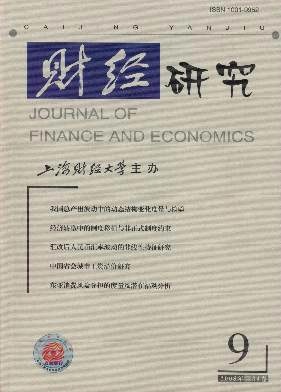中国省会城市工资溢价研究——基于分位数回归的空间计量分析
财经研究 2008 年 第 34 卷第 09 期, 页码:72 - 81
摘要
参考文献
摘要
文章利用2000-2006年中国营养与健康调查数据,从微观层面对中国省会与非省会城市之间的工资溢价效应进行研究。借助OLS基准模型发现,具有相似特征的工人,在省会城市工作获得的工资比在非省会城市平均高出14%。运用Mundlak-Cham-berlain随机效应模型,控制城市的生活成本,上述省会城市的工资溢价至少减少至7%,因此省会城市的工资溢价部分体现为对较高水平人力资本的回报。余下的工资溢价随着模型加入通勤时间而消失,这一结果和城市经济学空间均衡理论的预测相一致,并确定了省会城市聚集经济效应的存在。考虑到我国近年来工资收入差距的扩大,文章将研究扩展到工资分位数的研究,处于较高工资区间的工人明显享受到更多省会城市带来的优势。这些结果突出了城市劳动力市场微观层面研究的重要性。
[1]张建红,J Paul Elhorst,Arjen Van Witteloostuijn.中国地区工资水平差异的影响因素分析[J].经济研究,2006,(10):62-71.
[2]李金滟,宋德勇.专业化、多样化与城市聚集经济———基于中国地级单位面板数据的实证研究[J].管理世界,2008,(2):25-34.
[3]Adrian Colin Cameron,Pravin K,Trivedi.Microeconometrics:Methods and applica-tions[M].Cambridge University Press,2005:697-740.
[4]Brown C,Medoff J.The employer size-wage effect[J].The Journal of Political Econo-my,1998,97(5):1027-1059.
[5]Glaeser,Edward L,David C Mare.Cities and skills[J].Journal of Labor Economics,2001,19:316-342.
[6]Henderson J Vernon.Marshall’s scale economies[J].Journal of Urban Economics,2003,53:1-28.
[7]LeRoy,Stephen F,Jon Sonstelie.Paradise lost and regained:Transportation innovation,in-come,and residential location[J].Journal of Urban Economics,1983,13:67-89.
[8]Petitte,Ryan A,Stephen L Ross.Commutes,neighborhood effects,and compensatingeifferentials:Revisited[J].Journal of Urban Economics,1999,46:1-24.
[9]United Nations.World urbanization prospects:The 2005 revision[EB/OL].http://www.un.org/esa/population/publications/wup2007/.
[10]Wheaton,William C,Mark J Lewis.Urban wages and labor market agglomeration[J].Journal of Urban Economics,2002,51:542-562.
[11]Wheeler,Christopher H.Search,sorting and urban agglomeration[J].Journal of La-bor Economics,2001,19:879-899.
[12]Yankow,Jeffrey J.Why do cities pay more?An empirical examination of some compe-ting theories of the urban wage premium[J].Journal of Urban Economics,2006,60:139-161.
[2]李金滟,宋德勇.专业化、多样化与城市聚集经济———基于中国地级单位面板数据的实证研究[J].管理世界,2008,(2):25-34.
[3]Adrian Colin Cameron,Pravin K,Trivedi.Microeconometrics:Methods and applica-tions[M].Cambridge University Press,2005:697-740.
[4]Brown C,Medoff J.The employer size-wage effect[J].The Journal of Political Econo-my,1998,97(5):1027-1059.
[5]Glaeser,Edward L,David C Mare.Cities and skills[J].Journal of Labor Economics,2001,19:316-342.
[6]Henderson J Vernon.Marshall’s scale economies[J].Journal of Urban Economics,2003,53:1-28.
[7]LeRoy,Stephen F,Jon Sonstelie.Paradise lost and regained:Transportation innovation,in-come,and residential location[J].Journal of Urban Economics,1983,13:67-89.
[8]Petitte,Ryan A,Stephen L Ross.Commutes,neighborhood effects,and compensatingeifferentials:Revisited[J].Journal of Urban Economics,1999,46:1-24.
[9]United Nations.World urbanization prospects:The 2005 revision[EB/OL].http://www.un.org/esa/population/publications/wup2007/.
[10]Wheaton,William C,Mark J Lewis.Urban wages and labor market agglomeration[J].Journal of Urban Economics,2002,51:542-562.
[11]Wheeler,Christopher H.Search,sorting and urban agglomeration[J].Journal of La-bor Economics,2001,19:879-899.
[12]Yankow,Jeffrey J.Why do cities pay more?An empirical examination of some compe-ting theories of the urban wage premium[J].Journal of Urban Economics,2006,60:139-161.
引用本文
黄枫, 吴纯杰. 中国省会城市工资溢价研究——基于分位数回归的空间计量分析[J]. 财经研究, 2008, 34(9): 72–81.
导出参考文献,格式为:





 6850
6850  4442
4442

